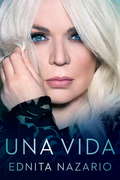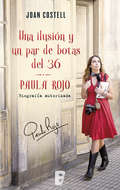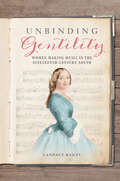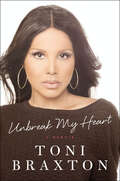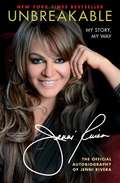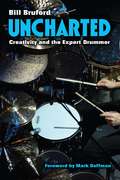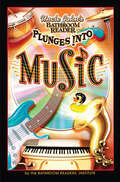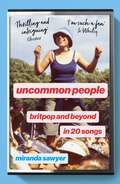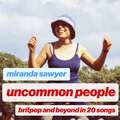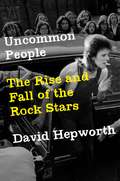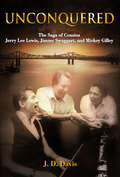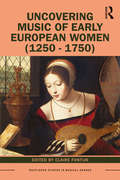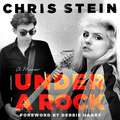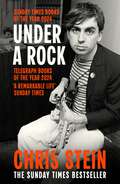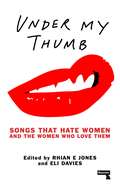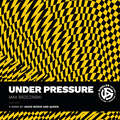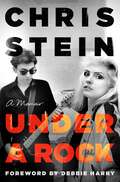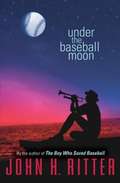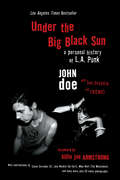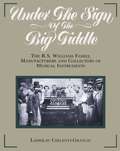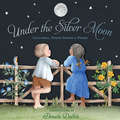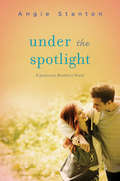- Table View
- List View
Un sueño por cumplir
by Sofía Surferss¡Una nueva aventura de Sofía Surferss! La carrera de Sofía Surferss no para de crecer. Tiene un montón de proyectos chulísimos, como grabar un anuncio superguay en Madrid. Además, su madre y su hermana también se vienen. ¡Viaje de chicas! Sin embargo, entre las muchas aventuras que les esperan en la gran ciudad, se esconde algún que otro contratiempo... ¡¿pero por qué tiene tanta mala suerte?! ¿Conseguirá Sofía salir airosa de todos sus accidentes y llegar a tiempo al rodaje? No te pierdas una nueva aventura de Sofía Surferss
Una Vida
by Ednita Nazario“Ednita siempre ha sido la “gran dama” que nos señaló el camino, con un espíritu de innovación, tenacidad y entendiendo lo que es la música actual”. —Ricky Martin Pocos cantantes han sido capaces de generar el interés internacional y multigeneracional del que ha disfrutado la artista Ednita Nazario. Una de las estrellas del pop latino más admiradas y con más grabaciones que han resultado en hits, es reconocida por su riqueza vocal y su magnética presencia en los escenarios. En estas páginas Ednita, la diva más amada de Puerto Rico, por primera vez abre su corazón narrando su vida entera, con detalles nunca antes revelados al público. Desde sus humildes comienzos en Ponce, pasando por la pérdida de su gran amor, la bancarrota emocional y financiera y finalmente el regreso al estrellato. Ednita nos abre su corazón y su historia con absoluta sinceridad y transparencia, desde los momentos más felices de su vida hasta los más desgarradores. Una historia de inspiración, amor, familia: esta es Ednita Nazario con toda la pasión y el talento que la han convertido en una de las estrellas más celebradas de nuestra era.
Una ilusión y un par de botas del 36. Biografía autorizada de Paula Rojo
by Joan CostellLa biografía oficial de la cantante Paula Rojo. Un precioso libro repleto de fotografías inéditas en el que la artista nos cuenta todo sobre su vida, su carrera, sus ambiciones y sus aficiones. Desde su aparición en La Voz, el popular talent show, la vida de Paula Rojo cambió por completo y, aunque quedó a las puertas de la semifinal, enamoró de forma unánime a todos los espectadores. Su dulce voz, sus composiciones y su personal estilo interpretativo cautivaron a todo el país, y Paula se convirtió en «la chica del ukelele». Cientos de conciertos por escenarios de toda España, infinidad de apariciones en televisión (y medios en general), decenas de colaboraciones con otros artistas y una legión fiel de seguidores, son los avales que hacen que Paula Rojo se haya convertido en una artista a tener muy en cuenta.
Unbinding Gentility: Women Making Music in the Nineteenth-Century South (Music in American Life #1)
by Candace BaileyHearing southern women in the pauses of history Southern women of all classes, races, and walks of life practiced music during and after the Civil War. Candace L. Bailey examines the history of southern women through the lens of these musical pursuits, uncovering the ways that music's transmission, education, circulation, and repertory help us understand its meaning in the women's culture of the time. Bailey pays particular attention to the space between music as an ideal accomplishment—part of how people expected women to perform gentility—and a real practice—what women actually did. At the same time, her ethnographic reading of binder’s volumes, letters and diaries, and a wealth of other archival material informs new and vital interpretations of women’s place in southern culture. A fascinating collective portrait of women's artistic and personal lives, Unbinding Gentility challenges entrenched assumptions about nineteenth century music and the experiences of the southern women who made it.
Unbreak My Heart: A Memoir
by Toni BraxtonThe bestselling solo R&B artist finally opens up about her rocky past and her path to redemptionWhile Toni Braxton may appear to be living a charmed life, hers is in fact a tumultuous story: a tale of personal triumph after a public unraveling. In her heartfelt memoir, the six-time Grammy Award-winning singer and star of WE tv's hit reality series Braxton Family Values is unapologetically honest in revealing the intimate details of her journey.Toni and the entire Braxton clan have become America's favorite musical family, but what fans may not know is the intense guilt Toni once felt when she accepted a recording deal that excluded her sisters. That decision would haunt Toni for years to come, tainting the enormous fame she experienced as a popular female vocalist at the top of the charts. Despite her early accomplishments, Toni's world crumbled when she was forced to file for bankruptcy twice and was left all alone to pick up the pieces.Always the consummate professional, Toni rebuilt her life but then found herself in the midst of more heartache. The mother of an autistic child, Toni had long feared that her son's condition might be karmic retribution for some of the life choices that left her filled with remorse. Later, when heart ailments began plaguing her at the age of forty-one and she was diagnosed with lupus, Toni knew she had to move beyond the self-recrimination and take charge of her own healing—physically and spiritually.Unbreak My Heart is more than the story of Toni's difficult past and glittering success: it is a story of hope, of healing, and, ultimately, of redemption.
Unbreakable: My Story, My Way
by Jenni RiveraThe story behind Telemundo&’s Jenni Rivera: Mariposa del Barrio series, now streaming. A New York Times bestseller, this is the official biography from the beloved Mexican-American singer who lost her life in a tragic plane crash.The only autobiography authorized by Jenni Rivera "I can’t get caught up in the negative because that destroys you. Perhaps trying to move away from my problems and focus on the positive is the best I can do. I am a woman like any other, and ugly things happen to me like any other woman. The number of times I have fallen down is the number of times I have gotten up." These are the last words that beloved Mexican American singer Jenni Rivera spoke publicly before boarding the plane that would crash and cut her life short on December 9, 2012. However, they are not the final words that La Diva de la Banda had for the world. Those are found in the pages you hold in your hands, Jenni’s own account of the highs and lows of her extraordinary journey. She became the most acclaimed Spanish-language singer in the United States and sold more than 15 million records worldwide. A single mother of five and grandmother of two, she was also an actress, a television producer, the star of her own reality show, and an entrepreneur. But for all its immense success, Jenni’s life often seemed to be a series of personal battles in which perseverance was her only weapon. As her fame grew, she made it her mission to speak about her struggles, forging an intimate connection with her fans. She became a figure of strength and a source of encouragement to women of all ages. In Unbreakable, Jenni recounts the crucial moments in her past, revealing her experiences with domestic and sexual abuse, divorce, body image issues, making her way in a male-dominated industry, raising her children as a single mother, and learning that she could depend only on herself. Though she is no longer with us, Jenni will always be the "Rivera rebel from Long Beach," the girl who maintained her sense of humor and fighting spirit in every circumstance. In this remarkable memoir, Jenni leaves behind a legacy of inspiration and determination that will forever live on through her precious family, friends, and fans.
Uncharted: Creativity and the Expert Drummer
by Bill BrufordWhat do expert drummers do? Why do they do it? Is there anything creative about it? If so, how might that creativity inform their practice and that of others in related artistic spheres? Applying ideas from cultural psychology to findings from research into the creative behaviors of a specific subset of popular music instrumentalists, Bill Bruford demonstrates the ways in which expert drummers experience creativity in performance and offers fresh insights into in-the-moment interactional processes in music. An expert practitioner himself, Dr. Bruford draws on a cohort of internationally renowned, peak-career professionals and his own experience to guide the reader through the many dimensions of creativity in drummer performance.
Uncle John's Bathroom Reader Plunges Into Music (Uncle John's Bathroom Reader)
by Bathroom Readers' InstituteAn entertaining trivia compendium flush with fun facts about all things music. From boogie-woogie to Beethoven, from Prince to Pavarotti, from the bards of Broadway to the rebels of rock &’n&’ roll—it&’s all here. Uncle John has created this harmonious collection of tuneful tales for music lovers everywhere. Uncle John has proven once again that he is in tune with our legion of loyal readers. This 516-page musical masterpiece dedicated to all things noteworthy ranges from silly one-hit wonders to culture-changing musical milestones. You&’ll get a glimpse into the future of music and go back to the days when prehistoric man first started communicating in song. So, plug in your amp, turn the dial up to eleven, and have a blast reading about: · The origins of nearly every genre and style of music—including rock, country, jazz, the blues, rhythm-and-blues, hip hop, punk, folk, polka, opera, Muzak, disco, and even marching bands · Musical legends, from &“outsiders&” like the Shaggs and the Carter family, to giants like the Beatles, Elvis, and Weird Al Yankovic · The stories of legendary music venues like the Grand Ole Opry, the Apollo, and the Fillmore · How a computer glitch led to Right Said Fred&’s 1991 hit &“I&’m Too Sexy&” · Why waltzing was considered as scandalous in its early days as rock was in its early days · The birth of the banjo, the electric guitar, karaoke, and the Stradivarius violin · How John Williams struck a universal chord with his score for Star Wars · Go underground to play the world&’s largest natural musical instrument · What happened at Woodstock and other weird concert mishaps And much, much more
Uncommon People: Britpop and Beyond in 20 Songs
by Miranda SawyerWhen Miranda Sawyer interviewed Noel Gallagher in 1995, his gag wishing Damon Albarn would die of AIDS became front-page news. This fascinating pop history, exploring the mid-90s moment when British music suddenly meant everything, explains why. Picking out twenty key songs, delving into the surprising stories behind them and their unlikely creators, Uncommon People takes us back to when Jarvis Cocker became a national hero, Trainspotting was a global hit, fire-starting seemed like a good night out - and it felt as though the revolution was happening.Initially a music press nickname, Britpop became an unexpected musical movement centred around outsiders and misfits, drop-outs and weirdos who refused to compromise on their ideas, even when they were thrust into the international spotlight. Not just a scene for white guys with guitars, but something wilder and more interesting, with songs that have proved timeless. Exploring the era's key artists - Oasis, Blur, Tricky, Pulp, Underworld, Manic Street Preachers, The Prodigy, Suede, Chemical Brothers, Garbage, Supergrass, Radiohead, PJ Harvey and more - through their definitive anthems, Miranda Sawyer transports us back to the beating heart of the nineties.Uncommon People re-lives the mad exhilaration of what it was like to hear these songs for the very first time - and what it was like to make them. With amazing new interviews, and I-was-there insights, this book offers a backstage pass to all the most interesting bits of Britpop's Greatest Hits.Forget New Labour, forget earnest trend theories, this book is all about the music, the people and being right there, right now.
Uncommon People: Britpop and Beyond in 20 Songs
by Miranda SawyerWhen Miranda Sawyer interviewed Noel Gallagher in 1995, his gag wishing Damon Albarn would die of AIDS became front-page news. This fascinating pop history, exploring the mid-90s moment when British music suddenly meant everything, explains why. Picking out twenty key songs, delving into the surprising stories behind them and their unlikely creators, Uncommon People takes us back to when Jarvis Cocker became a national hero, Trainspotting was a global hit, fire-starting seemed like a good night out - and it felt as though the revolution was happening.Initially a music press nickname, Britpop became an unexpected musical movement centred around outsiders and misfits, drop-outs and weirdos who refused to compromise on their ideas, even when they were thrust into the international spotlight. Not just a scene for white guys with guitars, but something wilder and more interesting, with songs that have proved timeless. Exploring the era's key artists - Oasis, Blur, Tricky, Pulp, Underworld, Manic Street Preachers, The Prodigy, Suede, Chemical Brothers, Garbage, Supergrass, Radiohead, PJ Harvey and more - through their definitive anthems, Miranda Sawyer transports us back to the beating heart of the nineties.Uncommon People re-lives the mad exhilaration of what it was like to hear these songs for the very first time - and what it was like to make them. With amazing new interviews, and I-was-there insights, this book offers a backstage pass to all the most interesting bits of Britpop's Greatest Hits.Forget New Labour, forget earnest trend theories, this book is all about the music, the people and being right there, right now.
Uncommon People: Britpop and Beyond in 20 Songs
by Miranda SawyerWhen Miranda Sawyer interviewed Noel Gallagher in 1995, his gag wishing Damon Albarn would die of AIDS became front-page news. This fascinating pop history, exploring the mid-90s moment when British music suddenly meant everything, explains why. Picking out twenty key songs, delving into the surprising stories behind them and their unlikely creators, Uncommon People takes us back to when Jarvis Cocker became a national hero, Trainspotting was a global hit, fire-starting seemed like a good night out - and it felt as though the revolution was happening.Initially a music press nickname, Britpop became an unexpected musical movement centred around outsiders and misfits, drop-outs and weirdos who refused to compromise on their ideas, even when they were thrust into the international spotlight. Not just a scene for white guys with guitars, but something wilder and more interesting, with songs that have proved timeless. Exploring the era's key artists - Oasis, Blur, Tricky, Pulp, Underworld, Manic Street Preachers, The Prodigy, Suede, Chemical Brothers, Garbage, Supergrass, Radiohead, PJ Harvey and more - through their definitive anthems, Miranda Sawyer transports us back to the beating heart of the nineties.Uncommon People re-lives the mad exhilaration of what it was like to hear these songs for the very first time - and what it was like to make them. With amazing new interviews, and I-was-there insights, this book offers a backstage pass to all the most interesting bits of Britpop's Greatest Hits.Forget New Labour, forget earnest trend theories, this book is all about the music, the people and being right there, right now.
Uncommon People: The Rise and Fall of The Rock Stars
by David HepworthNamed one of the best music books of 2017 by The Wall Street JournalAn elegy to the age of the Rock Star, featuring Chuck Berry, Elvis, Madonna, Bowie, Prince, and more, uncommon people whose lives were transformed by rock and who, in turn, shaped our cultureRecklessness, thy name is rock.The age of the rock star, like the age of the cowboy, has passed. Like the cowboy, the idea of the rock star lives on in our imaginations. What did we see in them? Swagger. Recklessness. Sexual charisma. Damn-the-torpedoes self-belief. A certain way of carrying themselves. Good hair. Interesting shoes. Talent we wished we had. What did we want of them? To be larger than life but also like us. To live out their songs. To stay young forever. No wonder many didn’t stay the course.In Uncommon People, David Hepworth zeroes in on defining moments and turning points in the lives of forty rock stars from 1955 to 1995, taking us on a journey to burst a hundred myths and create a hundred more.As this tribe of uniquely motivated nobodies went about turning themselves into the ultimate somebodies, they also shaped us, our real lives and our fantasies. Uncommon People isn’t just their story. It’s ours as well.
Unconquered: The Saga of Cousins Jerry Lee Lewis, Jimmy Swaggart, and Mickey Gilley (Unconquered Ser.)
by J.D. Davis&“Engaging . . . [a] biography of three men bound by blood, music, and a lifelong struggle to strike a balance between the sacred and secular.&”—Publishers WeeklyThree cousins, inseparably bonded through music. Each became a star; their story would become a legend. J. D. Davis&’s enthralling new biography of famous cousins Jerry Lee Lewis, Jimmy Swaggart, and Mickey Gilley, born within a twelve-month span in small-town Louisiana during the Great Depression, draws from exhaustive research and personal connections with friends and family. Davis recreates the irresistible and life-changing power of music that surrounded the cousins as boys and shaped their engagingly distinct paths to fame. With three personal journeys set alongside important landmarks in pop-culture history, Davis presents a unique tale of American music centered on the trials, tribulations, and achievements of three men who remain truly Unconquered.A ForeWord Reviews Book of the Year Award Honorable Mention for Biography&“This is a good read, and not just for the hard-core fan. It will appeal to anyone interested in the dynamics of rock &’n&’ roll, country music, and evangelical Christianity and what happens when the aesthetics and lifestyles of those three worlds collide. Highly recommended.&”—Library Journal&“God, the devil, and everything in between. This book is a great representation of the duality plane on which we exist.'&”—Leon Russell, legendary musician, Rock and Roll Hall of Fame member &“Unconquered clearly depicts the fascinating story of three great musical artists who were cousins in real life but icons in the world of music. Each man conquered life&’s roadblocks to achieve his ultimate goals.&”—Tom Schedler, former Louisiana Secretary of State
Uncovering Music of Early European Women (1250-1750)
by Claire FontijnUncovering Music of Early European Women (1250 – 1750) brings together nine chapters that investigate aspects of female music-making and musical experience in the medieval and early modern periods. Part I, "Notes from the Underground," treats the spirituality of women in solitude and in community. Parts II and III, "Interlude" and "Music for Royal Rivals," respond to Joan Kelly’s famous feminist question and suggest that women of a certain stature did have a Renaissance. Part IV, "Serenissime Sirene," plays with the notion of the allure of music and its risks in Venice during the Baroque. The process of uncovering requires close listening to women’s creative endeavors in an ongoing effort to piece together equitably the terrain of early music. Contributors include: Cynthia J. Cyrus, Claire Fontijn, Catherine E. Gordon, Laura Jeppesen, Eva Kuhn, Anne MacNeil, Jason Stoessel, Elizabeth Randell Upton, and Laurence Wuidar. An invaluable book for college students and scholars interested in the social and cultural meanings of women in early music.
Under A Rock
by Chris SteinThis audiobook includes the song 'Heartbreak Kid', an exclusive early track from Blondie's forthcoming album'Sometimes fate deals up a wild card. There's a lot to be said for one of these wild cards and from what I've learned over the fifty or so years of our friendship, Chris is a card from the unexpected deck' - from the foreword by Debbie HarryMusician, photographer, storyteller, and longtime partner to Debbie Harry, Chris Stein defined the sound of an era, catapulting the icon band Blondie to #1 and selling over 20 million copies of Parallel Lines.In this no-holds-barred autobiography, Stein reveals himself-this time not in songwriting or photography, which he's previously been known for, but in words. From a Brooklyn boyhood, a move across the river to the gritty and fecund East Village in the late 1970s allowed Stein to tap the explosive creativity that defined the era in the city. It was a time when David Bowie and the Ramones were also making music, when Andy Warhol was still alive and promoting Jean-Michel Basquiat's work, when cool was defined not by where you came from but by what you could contribute to culture.UNDER A ROCK is a plunge into that vanished time period, and into the moments that turned the fresh sound and new look of punk and new wave into a giant artistic and commercial sensation. Stein takes us there in this revelatory, propulsive, distinctive memoir.
Under A Rock
by Chris Stein'Sometimes fate deals up a wild card. There's a lot to be said for one of these wild cards and from what I've learned over the fifty or so years of our friendship, Chris is a card from the unexpected deck' - from the foreword by Debbie HarryMusician, photographer, storyteller, and longtime partner to Debbie Harry, Chris Stein defined the sound of an era, catapulting the icon band Blondie to #1 and selling over 20 million copies of Parallel Lines.In this no-holds-barred autobiography, Stein reveals himself-this time not in songwriting or photography, which he's previously been known for, but in words. From a Brooklyn boyhood, a move across the river to the gritty and fecund East Village in the late 1970s allowed Stein to tap the explosive creativity that defined the era in the city. It was a time when David Bowie and the Ramones were also making music, when Andy Warhol was still alive and promoting Jean-Michel Basquiat's work, when cool was defined not by where you came from but by what you could contribute to culture.UNDER A ROCK is a plunge into that vanished time period, and into the moments that turned the fresh sound and new look of punk and new wave into a giant artistic and commercial sensation. Stein takes us there in this revelatory, propulsive, distinctive memoir.
Under My Thumb: Songs That Hate Women and the Women That Love Them
by Rhian Jones Eli Davies Tamar ShlaimDiscussions and analyses of music – whether on TV, in books or in the music press – have always been full of the stories of men. When female fans appear in these stories it is often through the eyes and from the perspectives of men – as muses, groupies or fangirls – meaning that women’s own experiences, ideas and arguments about the music they love are marginalised or glossed over. Women in music are frequently fetishised and objectified both in song lyrics and in real life, viewed purely in relation to men and through their impact on the male ego. But this hasn’t stopped generations of women from loving, being moved by and critically appreciating music – however that music may feel about them.Under My Thumb: The Songs that Hate Women and the Women Who Love Them is a study of misogyny in music through the eyes of women. It will bring together stories from music writers and fans about artists or songs they love despite their questionable or troubling gender politics, as well as looking at how these issues intersect with race, class and sexuality.The collection explores the joys of loving music and the tensions, contradictions and complexities it can involve. It is intended to be as much celebration as critique - a kind of feminist guilty pleasures.
Under Pressure: A Song by David Bowie and Queen (Singles)
by Max BrzezinskiIn 1981, David Bowie and Queen both happened to be in Switzerland: They met and made “Under Pressure.” Recorded on a lark, the song broke the path for subsequent pop anthems. In Under Pressure, Max Brzezinski tells the classic track’s story, charting the relationship between pop music, collective politics, and dominant institutions of state, corporations, and civil society. Brzezinski shows that, like all great pop anthems, “Under Pressure” harnesses collective sentiments in order to model new ways of thinking and acting. As we continue to live under the sign of the global oppressive power the song names, analyzes, and attempts to move beyond, we remain, in Bowie and Freddie Mercury’s phrase, under pressure.
Under a Rock: A Memoir
by Chris SteinForeword by Debbie Harry"A Downtown Memory" by Romy AshbyDebbie Harry defined iconic band Blondie’s look. Chris Stein—her performing partner, lover, and lifelong friend—was its architect and defined its sound. “Parallel Lines”, their third album, catapulted to #1, sold 20 million copies, and launched singles like “Heart of Glass”, "Hangin' On the Telephone," and “One Way or Another”, providing the beat when Bianca Jagger and Halston danced at Studio 54 and the soundtrack to every 1970’s punk-soundtracked romance. Chris Stein knows how to tell a story. Under A Rock is his nothing-spared autobiography. It's about the founding of the band, ascending to the heights of pop success, and the hazards of fortune.Famous names march through these pages—Warhol, Bowie, Jean-Michel Basquiat, and more–but you can get famous names anywhere. What you can’t get anywhere else is a plunge into the moments that made a giant 1980's artistic sensation. Stein takes us there in this revelatory, propulsive, distinctive memoir.
Under the Baseball Moon
by John H. RitterAndy Ramos dreams of taking his unique fusion of Latin jazz, rock, and hip-hop straight to the top. When he crosses paths with a softball pitcher with Olympian dreams, the mysterious fusion of their athletic and musical skills changes everything.
Under the Big Black Sun: A Personal History Of L. A. Punk
by John Doe Tom DesaviaUnder the Big Black Sun explores the nascent Los Angeles punk rock movement and its evolution to hardcore punk as it's never been told before. Authors John Doe and Tom DeSavia have woven together an enthralling story of the legendary west coast scene from 1977-1982 by enlisting the voices of people who were there. The book shares chapter-length tales from the authors along with personal essays from famous (and infamous) players in the scene. Additional authors include: Exene Cervenka (X), Henry Rollins (Black Flag), Mike Watt (The Minutemen), Jane Wiedlin and Charlotte Caffey (The Go-Go's), Dave Alvin (The Blasters), Jack Grisham (TSOL), Teresa Covarrubias (The Brat), Robert Lopez (The Zeros, El Vez), as well as scencesters and journalists Pleasant Gehman, Kristine McKenna, and Chris Morris. Through interstitial commentary, John Doe "narrates" this journey through the land of film noir sunshine, Hollywood back alleys, and suburban sprawl-the place where he met his artistic counterparts Exene, DJ Bonebrake, and Billy Zoom-and formed X, the band that became synonymous with, and in many ways defined, L.A. punk. Under the Big Black Sun shares stories of friendship and love, ambition and feuds, grandiose dreams and cultural rage, all combined with the tattered, glossy sheen of pop culture weirdness that epitomized the operations of Hollywood's underbelly. Readers will travel to the clubs that defined the scene, as well as to the street corners, empty lots, apartment complexes, and squats that served as de facto salons for the musicians, artists, and fringe players that hashed out what would become punk rock in Los Angeles.
Under the Sign of the Big Fiddle: The R.S. Williams Family, Manufacturers and Collectors of Musical Instruments
by Ladislav Cselenyi-GranchMusical-instrument manufacturing was one of the few areas in which Canada was able to compete with the United States and England in the 19th and early 20th centuries. This book describes one of the leading firms in the music industry in Canada at that time. The Toronto business that was conducted under the sign of the "Big Fiddle" added significantly to the spread of music in the city of Toronto and far beyond. The founder of this family business was Richard Sudgen Williams. With his son, R.S. Williams Jr., he is also responsible for amassing what is perhaps the earliest collection of musical instruments in Canada, and what is certainly one of the largest. Of great documentary significance and value to this book are the catalogues published by the R.S. Williams firm that the author consulted during his extensive research. Of the ten catalogues cited, three can be found as part of the R.S. Williams Collection in the Royal Ontario Museum. The rest reside in the National Library of Canada and in the personal collection of Michael Remenyi in Toronto.
Under the Silver Moon: Lullabies, Night Songs & Poems
by Pamela DaltonCut-paper artist Pamela Dalton's magically intricate illustrations illuminate a generous collection of lullabies and goodnight poems. Recalling traditional favorites from childhood and embracing a wide range of sources and cultures, this timeless collection makes a lovely addition to any e-bookshelf or bedtime read-aloud ritual. Sure to enchant both children and their parents, Dalton's exquisite detail and sophisticated aesthetic—always informed by warmth and a deep humanity—will speak to anyone looking for the perfect book for a newborn.
Under the Spotlight
by Angie StantonAfter an embarrassing stint on a reality-TV music competition years ago, Riley vowed never to sing again. Now she's behind the scenes, working at the prestigious Sound Sync recording studio, and life is looking up. But then Garrett Jamieson, the oldest brother in the famous Jamieson brothers band, crashes into her world.Garrett has hit rock bottom, and he is desperate to reinvent himself. After calling in a few favors, he ends up working at Sound Sync to learn the ropes of record producing from the industry's best. And he can't believe his luck when he discovers that Riley has been keeping a secret--she is an amazing singer. By producing her album, he's sure to top the record charts again. But Garrett is forced to use every trick in his arsenal to persuade the sassy girl to record.Riley refuses to sing--or even entertain the thought of it--and sparks fly as Garrett finally meets his match. But in the heat of the moment, one stolen kiss changes everything. Will Riley be the first person to finally rein Garrett in, or will Garrett succeed in getting Riley back under the spotlight?
Undergraduate Research in Architecture: A Guide for Students (Routledge Undergraduate Research Series)
by Jenny Olin Shanahan Gregory Young D. Andrew VernooyUndergraduate Research in Architecture: A Guide for Students supplies tools for scaffolding research skills, with examples of undergraduate research activities and case studies on projects in the various areas of architecture study. Undergraduate research has become a common degree requirement in some disciplines and is growing rapidly. Many undergraduate activities in music have components that could be combined into compelling undergraduate research projects, either in the required curriculum, as part of existing courses, or in capstone courses centered on undergraduate research.Following an overview chapter, the next seven chapters cover research skills including literature reviews, choosing topics, formulating questions, citing sources, disseminating results, and working with data and human subjects. A wide variety of sub-disciplines follow in the remaining chapters, with sample project ideas from each as well as undergraduate research conference abstracts. The final chapter is an annotated guide to online resources. Included are some inspirational quotations concerning architecture’s commitment to research, and some examples of professional research that support the focus of the chapter. All chapters end with relevant questions for discussion.

